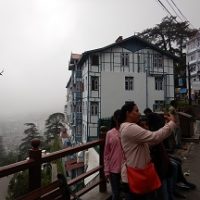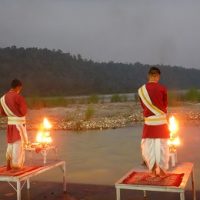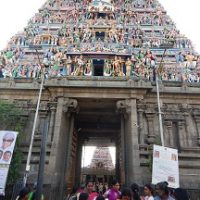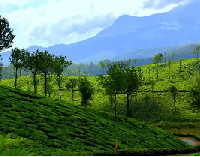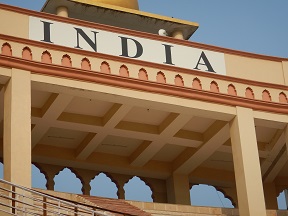Written by Gayathri Gopinath.
Introduction by her Father:
Ever since we went on a North Indian tour in July 2018, I was behind my children Nandakishor and Gayathri to write their own account of our travel following my long story published in this blog called Discover India – North India Tour with family, a travelogue. After that long and intermittent persuasion, I got a product out of Nandan recently called My First India Tour.
Following that success, I went onto follow-up with Gayathri. They are twins studying in the in The Indian High School (IHS) of Dubai in 9th std. That ended up being a tougher fight. Finally, I pulled out a hunger strike to bring her to deliver the story.
Table of Contents
Introduction:
This summer vacation we had planned to visit north India as we had never been to the north of India. My father has a great passion for travelling and had always looked up to North India as a beautiful area to explore. He also wanted me and my brother to visit North India and learn more about it. He gave us a book named India (By Lonely Planet), which is a travel guide and has a lot of facts about the different culture and traditions of the variety of places in India.
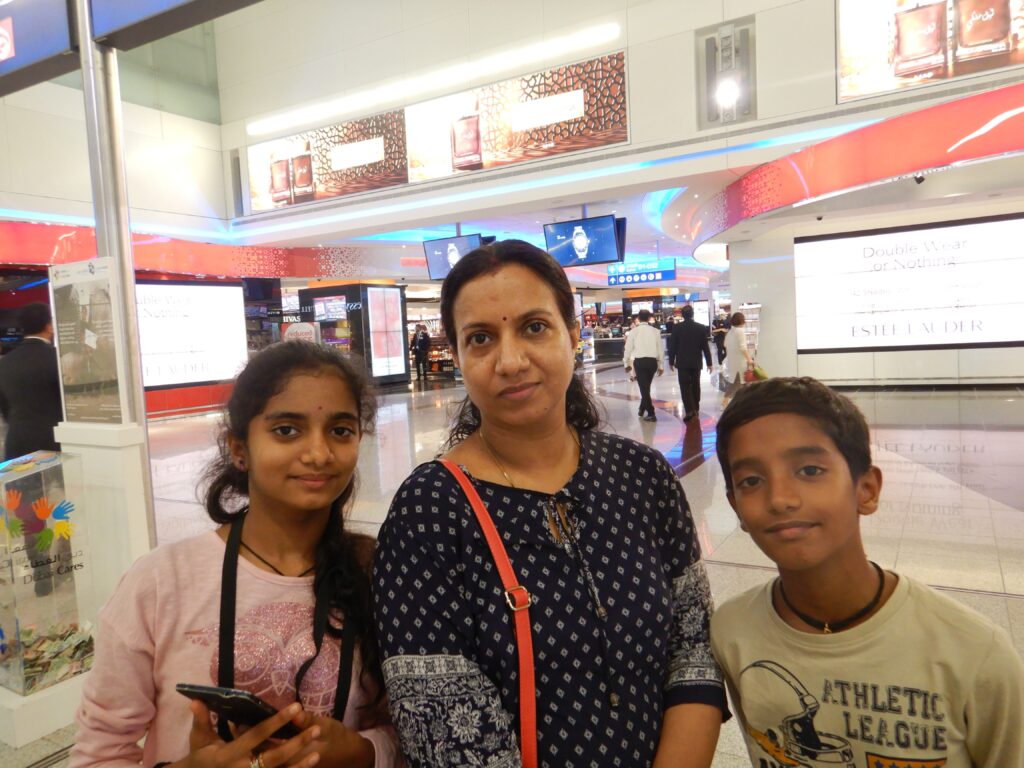 Introduction, at the Dubai Airport – Preparing for a Journey of exploration!
Introduction, at the Dubai Airport – Preparing for a Journey of exploration!
So, we began our journey from Dubai airport and reached Delhi. I had always been eager to know about Delhi, as most of India’s attractive monuments and tourist wonders are found here.
Reaching New Delhi; Visiting Qutb Minar, India Gate, and the Red Fort.
The Indira Gandhi International airport astounded me a lot as I had been there for the first time. We had very less time, so we moved quickly from the airport and got a taxi. We had our first visit to the Qutb Complex, which is the official name of the area housing the Qutb Minar.
It is a complex of the famous monuments constructed during the Mamluk Dynasty by the great rulers of the kingdom.
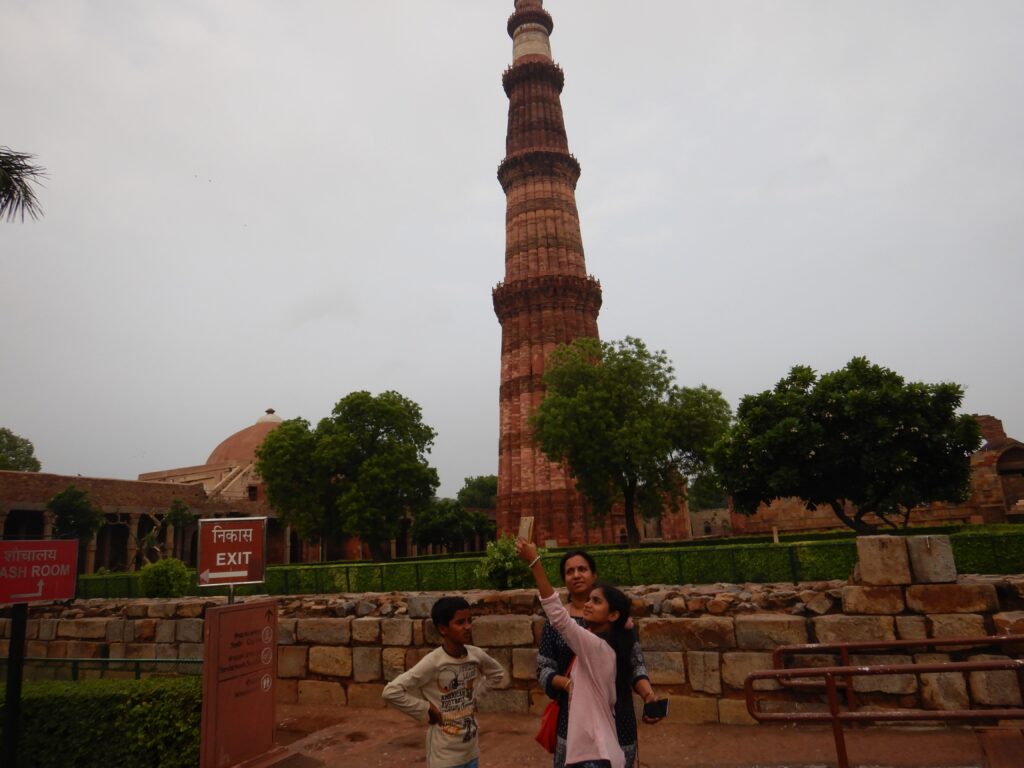 At Qutb Minar; in front of the Minaret
At Qutb Minar; in front of the Minaret
 At Qutb Minar – the dancer in me wanted to pose!
At Qutb Minar – the dancer in me wanted to pose!
 Feeling proud at the India Gate of New Delhi!
Feeling proud at the India Gate of New Delhi!
The India gate is special for the names of various soldiers who are remembered as the striving martyrs of our country, that have been carved on its surface. Then we went to a hotel to have lunch. After the lunch we went to the cargo office to send our luggage to Kerala by courier as we had a lot of luggage and it would be very difficult to manage the luggage while enjoying the places.
Next Destination: Shimla
Our next destination was Shimla, which was a hill station that I was eagerly waiting to see. By evening we were ready to board the Kalka Shatabdi, which is a very popular train that departs from Delhi and arrives at Kalka.
We had to go to Kalka first as there is no direct train from Delhi to Shimla.
As our journey was from evening to midnight, I could not really enjoy all the scenes outside, but was happy on hearing that we will have to travel through the Kalka Shatabdi many times again and that it would be a regular train for our future visits.
Reaches Kalka on the way to Shimla.
We reached Kalka late night at 10 pm. From Kalka there was a toy train to Shimla, early morning.
We had booked a room in a hotel to stay till dawn. After our stay there, we boarded the toy train named Shimla express in the morning 4 AM. I am in the Toy Train to Shimla
I am in the Toy Train to Shimla
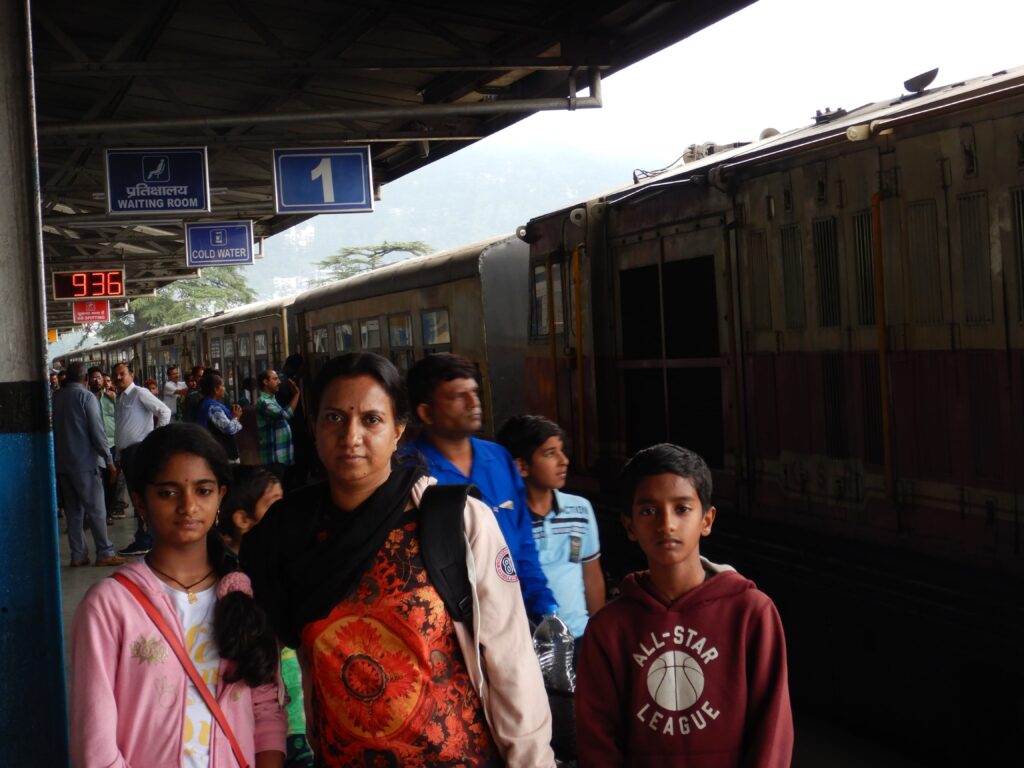 Toy Train at last in Shimla station
Toy Train at last in Shimla station
The most particular feature of this train is that it runs through a narrow-gauge rail, which means the track is much narrower than of normal standard trains. Most narrow-gauge railways are between 600mm and 1067mm. Shimla is located at 7116 feet in the foothills of the Himalayas.
In the earliest times Shimla became the summer capital of British India and was also the headquarters of the Indian army. It meant that the government of the British India would be transferred in the summer to Shimla by horse and ox carts. It is said that in 1863, the Viceroy of India, John Lawrence, decided to shift the summer capital of the British Raj to Shimla.
My father explained about these to me and my brother while travelling in the toy train. Shimla is regarded as the capital of the state of Himachal Pradesh. I was very excited to watch all the beautiful scenes during the journey from Kalka to Shimla. The track had 103 tunnels and 969 bridges. The scene of the beautiful mountains and valleys broadens our minds and makes us admire India’s green and serene nature.
The waterfalls at the edge of most of the bridges were very beautiful. I found Shimla more distinct from all other places we visited also because the Toy train journey was an amazing experience through pristine mountainous region.
Arrives at Shimla: India’s best Hill Station!
We reached Shimla around 11am and was waiting for a taxi near the railway station. We got into a taxi and met a driver named Bhim, he told us about the other famous places in Shimla other than what we knew and had decided to visit.
Our first destination in Shimla was the Jakhoo temple, which was the temple of the God Hanuman. The temple is situated very high and could only be reached through the ropeway, but that day the ropeway was not open, so Bhim uncle took us through very high, curvy roads and he also mentioned that it is not very easy to ride through the road by a car.
 At the Jakhoo Temple in Shimla
At the Jakhoo Temple in Shimla
 In front of the Hanuman Statue – Jakhoo temple, Shimla!
In front of the Hanuman Statue – Jakhoo temple, Shimla!
The temple had a huge statue of hanuman, which can be seen during the journey in the Toy train and from any part of Shimla. After reaching the place through the car we had to climb many stairs too to reach the temple. There were notice boards telling not to have mobile phones, spectacles, and other belongings in hand as there is a trouble of monkeys in that area. So, we had to be careful. When we returned from the Jakhoo temple I noticed the beautiful, long pine trees that surrounded the entire Shimla.
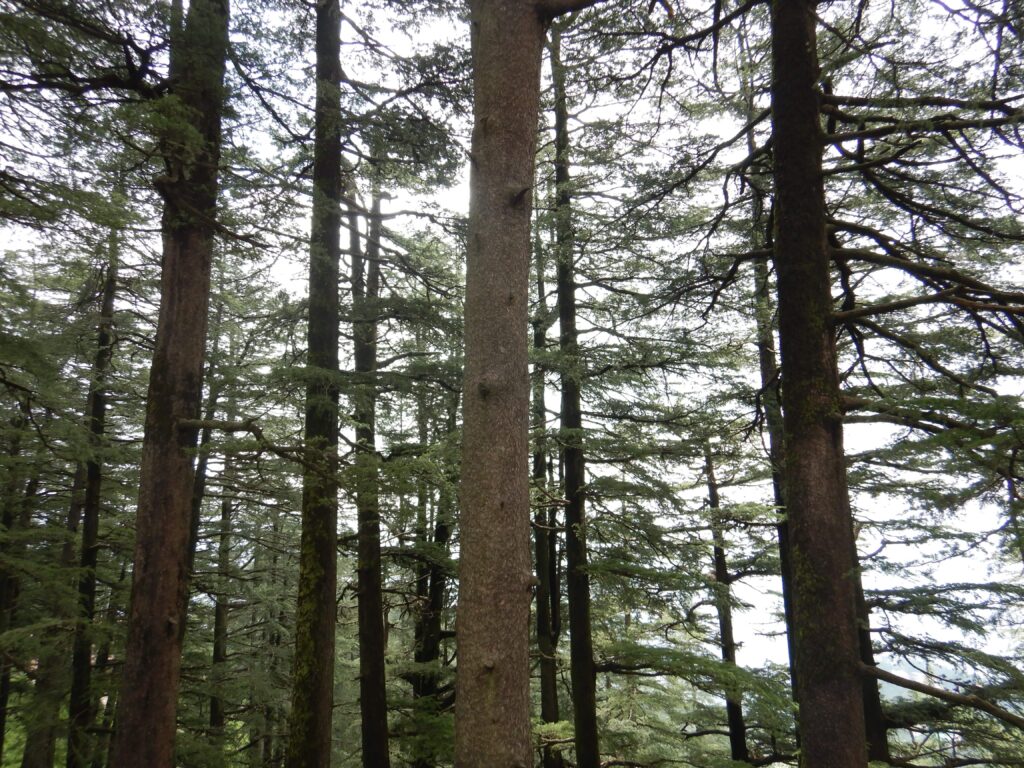 Beautiful Pine Trees all around Shimla
Beautiful Pine Trees all around Shimla
Bhim uncle also told a name [in Hindi] for them which was Deodar. We had our stay in a hotel named Alpine heritage.
 At the beautiful Hotel Alpine Heritage
At the beautiful Hotel Alpine Heritage
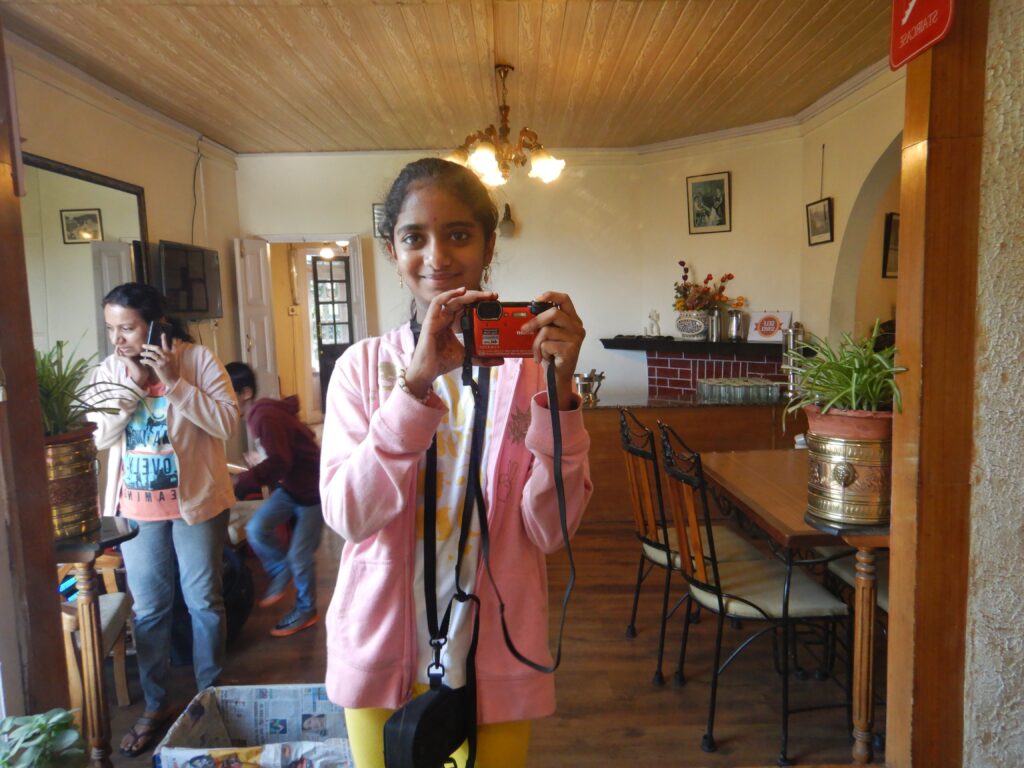 Preparing for a Shot at the Alpine Heritage Hotel, Shimla!
Preparing for a Shot at the Alpine Heritage Hotel, Shimla!
The hotel seemed very different to me because it was entirely built in wood and the view from the courtyard was amazing. We went next to Kufri. On the way to Kufri we stopped at Green valley.
Green valley is a beautiful spot for taking photographs and gives the visitors a complete view of the green mountains and hills of Shimla. Kufri is a hill station in Shimla. Kufri is known for its wildlife zoo and the production of Apples. We could not make up to the main fields of Kufri. Yak is a widely known animal in Shimla. We can see it in various places in Shimla. The well-known Oberoi Wild Flower Hall hotel was also a part of our list however, there was a conference going on there and so we were denied entry.
 Oberoi Wild Flower Hall Hotel
Oberoi Wild Flower Hall Hotel
Picture Courtesy : Trivago.com
The heritage hotel in Shimla, Wildflower hall was reconstructed from the former residence of Lord Kitchener (better known as “Lord Kitchener of Khartoum”) into a magnificent hotel residence which surprises tourists for its recreation of the grand style of the colonial era.
The hotel located amidst the long-scattered cedar and pine woods provides a serene atmosphere at 8250 feet in the magnificent Himalayas.
In spite I had also read as part of some of my researches prior to making this visit that a stay in here is like a fairytale coming to life.
Next destination is Chandigarh, making way to Punjab’s Amritsar!
I still remember how Bhim uncle was forced to drive at extremely high speeds to make it possible for us to reach the Railway station. Finally, after an exhausting car drive, we reached Chandigarh to leave for Amritsar.
After the train travel we reached Amritsar late night. Unfortunately, the Auto rickshaw driver could not locate the hotel we had booked and there was no other way than renting another hotel during those late hours. My father was disturbed by the circumstance that occurred unprecedently, as it was an unknown place completely deserted with unmaintained small city roads and murky. I was a little scared by what happened that night but was eagerly waiting to visit the Golden temple. The golden temple, Harmaindar Sahib is surrounded by other milky white temples.
 About to enter the Golden Temple
About to enter the Golden Temple
 Golden Temple – at the resting area next to the Temple pond
Golden Temple – at the resting area next to the Temple pond
 Golden temple – By the Temple Pond, marveling at the fishes
Golden temple – By the Temple Pond, marveling at the fishes
The Gurdwara is built around a man-made pool (sarovar) that was completed by the fourth Sikh Guru, in 1577. The Gurdwara is spiritually the most significant shrine in Sikhism. The temple’s dome is gilded with 750 kg of pure gold. Golden temple complex is a UNESCO heritage site and over 100,000 people are said to visit the temple every day.
I started feeling a little uncomfortable as we stood in the long queue which moved gradually as the pilgrims are allowed in very little numbers at one point of time.
I was feeling a little dizzy and required water. For some time, I felt like moving out of the queue and taking rest for a while. However, I knew well that it was practically impossible to have come out of the queue and rejoin.
I felt like having some water would make the condition better. My father managed to get some water from the busy crowd, but it did not help a lot. I started feeling more uncomfortable. The people in the crowd were so supportive that they allowed us to move farther more quickly. All their efforts were completely in vain as I was feeling worse being pushed by the crowd. I eventually sat down in the path as I cold not gather up the strength to stand. After a long time of dizziness, I finally made up to the main shrine and surprisingly started feeling better. Which I think would have been the impact of being able to visit the innermost shrine despite the disturbed health condition.
After praying we were directed to a long hall where I was given a sweet pink colored sacred water. After drinking that I felt much better. Me and my brother went towards the temple pond where we saw many beautiful fishes.
At the site of Jallianwala Bagh Massacre:
We went to the Jallianwala Bagh next. The Jallianwala Bagh is known for the massacre of the same name, that took place during the period of freedom struggle of the Indian nation. I had learnt about the Jallianwala Bagh in social studies at school.
 Amritsars Jalian Wala Bhagh – next to the depiction of British Soldier in the lawns!
Amritsars Jalian Wala Bhagh – next to the depiction of British Soldier in the lawns!
 Amritsars Jalian Wala Bhagh Bhagath Singh Statue
Amritsars Jalian Wala Bhagh Bhagath Singh Statue
The Jallianwala Bagh massacre, also known as the Amritsar massacre, took place when Brigadier-General Reginal Dyer ordered troops of the British Indian Army to fire their rifles into a crowd of unarmed Indian civilians in Jallianwala Bagh killing at least 379 people and injuring over 1,000 other people.
This place used to be considered as a meeting place for Indians during the period of freedom struggle. However due to the massacre it is now regarded as a memorial site. There is a lot of artwork and writings displayed, depicting what happened on that day. The bullet marks on the walls of the Jallianwala Bagh and the well in which people jumped to escape from the brutal firing of Dyer’s soldiers also stood as an evidence of the cruel atrocities during the British raj.
At the Wagah Border Ceremony:
Our next spot was he Wagah Border Ceremony. It was a much-awaited destination for my father. We arrived a bit late. It was a completely new experience witnessing the lowering of flags by the soldiers of the two neighbouring countries. I had also read that this ceremony that depicts an irony of the very well-known hostility of the two countries since the partition and moreover the cooperation and respect for one another has inspired many more countries to adopt similar ceremonies.
 Wagah Border Ceremony – at the entrance to the Gallery
Wagah Border Ceremony – at the entrance to the Gallery
 Wagah Border Ceremony – after finding a seat at the crowded visitors Gallery!
Wagah Border Ceremony – after finding a seat at the crowded visitors Gallery!
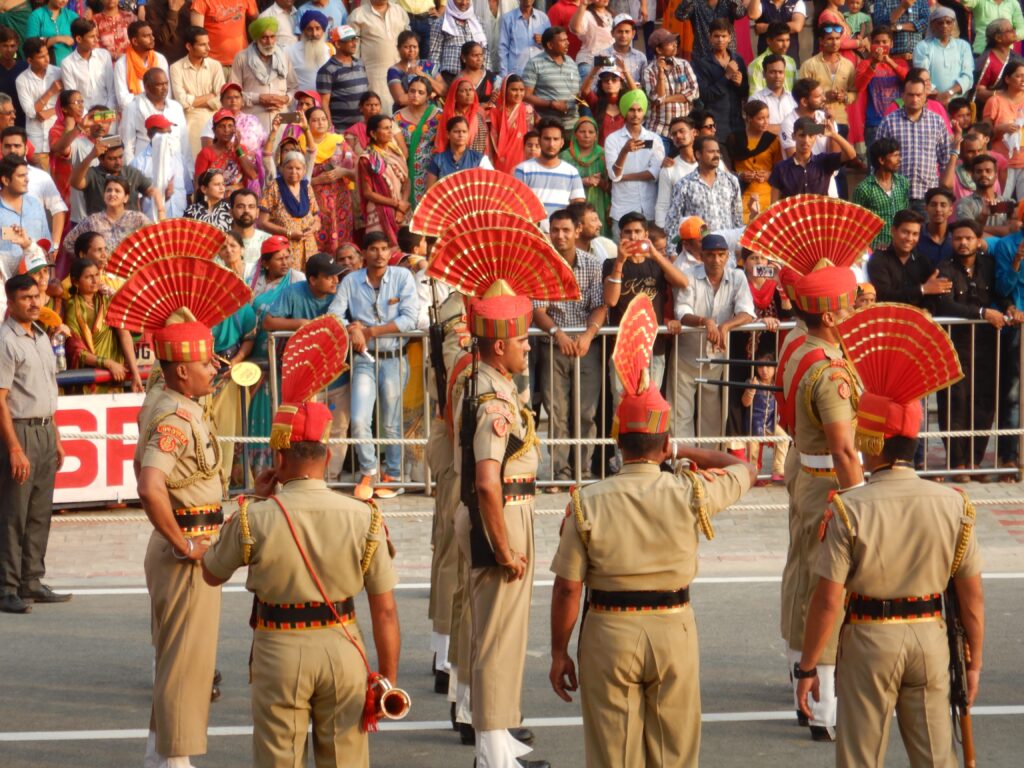 Wagah Border Ceremony – witnessing the progress
Wagah Border Ceremony – witnessing the progress
The arena created by the loud patriotic calls and the soldiers raising their legs as high as possible and giving out a respectful salute would bring out the pride of an Indian.
Back to Delhi to Travel to Udaipur; falls seriously ill:
We then left for Delhi by flight. After coming out of the Delhi IGI airport, we were waiting for a cab at the entrance.
This was one of the most exceptionally memorable experience to me. I was not feeling well again. Catching up for long and then it went out of my hands. I vomited right beside the entrance of the prestigious IGI airport.
This obviously became one of the best reasons that added up to my brother’s teasing. In fact, I still remember the constable standing at the entrance of the IGI airport, witnessing my situation and calling someone on their communication device. The CISF security person beside whom I sat, was glaring at me for my utterly disrespectful show at the prestigious airport. I still feel a little guilty when reminded of this. I was not really well. So we rushed towards our hotel that we had booked in Carol Bagh. After taking some rest I was feeling fine. Then my mother and brother also were not well. We all doubted that late night dinner we had the previous night at the Amritsar hotel caused the problems. Even when I, my brother and mother was extremely ill and could not get out of bed, my father was completely healthy. We took a 2-day time to get back our health, which led to the cancellation of our Udaipur trip. The Udaipur trip was a much awaited one for me personally because I helped father book a beautiful lake side hotel, the stay in which I was eagerly looking forward to.
After the two-day break, we went to meet my mother’s relative settled in Faridabad. I was eagerly waiting to go there mostly so that we would get some homely food of Kerala cuisine. I do not mean that I did not enjoy the vast varieties of dishes of the north Indian cuisine but having food from your home is something quite different.
After having a good dinner at their house, we left back to our hotel by the Delhi metro. It was my first time in a metro other than the Dubai metro I was used to travelling. But I must say the Delhi metro was definitely more than my expectations. It completely opened my mind to the modernity of India.
Off to Mathura and Taj Mahal:
Our next destination was the Taj Mahal through Mathura. Mathura is famous for being the birthplace of lord Krishna, which is said to be in the Shri Krishna Janmasthan Temple, situated there.
The main purpose of visiting Mathura would be going to the Shri Krishna Janmasthan Temple, Hindu temple for anyone and so was it for us. Honestly, when we reached the temple, I felt like we went back to one yug (the dvapar yuga), the time when the little lord Krishna was born and the everyone was stunned by his presence and naughtiness.
The temple is a must recommendation from my side for any devotee of Lord Krishna. At the entrance of the temple we saw many little adorable cows which reminded me of why everyone loved calling little Krishna “Gopala” (which meant the protector of the cow or cowherd).
The arena would be the right choice to meditate on the past times of the stealer of hearts and it symbolizes on the truly little things he used to do to steal the love of people. I was enjoying the ultimate bliss and the small deity of lord Krishna would melt the heart of any visitor. We also visited the ISKON temple which was of utmost importance to me and my brother as we regularly attend the Bhagavat geeta classes held in Dubai.
Having a good time in the surroundings of temple, prayers and devotion we moved out to our next spot which was the Taj Mahal built by Emperor Shah Jahan. The ever beautiful Taj Mahal built by emperor Shah jahan for his wife Mumtaz stands as a symbol of love and peace. It was too crowded and there were lot of people visiting on the day we went. I was completely mesmerized by the fact that even during the olden times, without any modern technology or equipment’s such an architecturally intricate and strongly sculptured fort topped by the natural bright colours obtained from the nature was built.
 Taj Mahal – Journey by the Hourse cart
Taj Mahal – Journey by the Hourse cart
 In front of the Taj Mahal
In front of the Taj Mahal
 Taj Mahal – Selfie Time
Taj Mahal – Selfie Time
 Taj Mahal – In front of the Great Monument of India
Taj Mahal – In front of the Great Monument of India
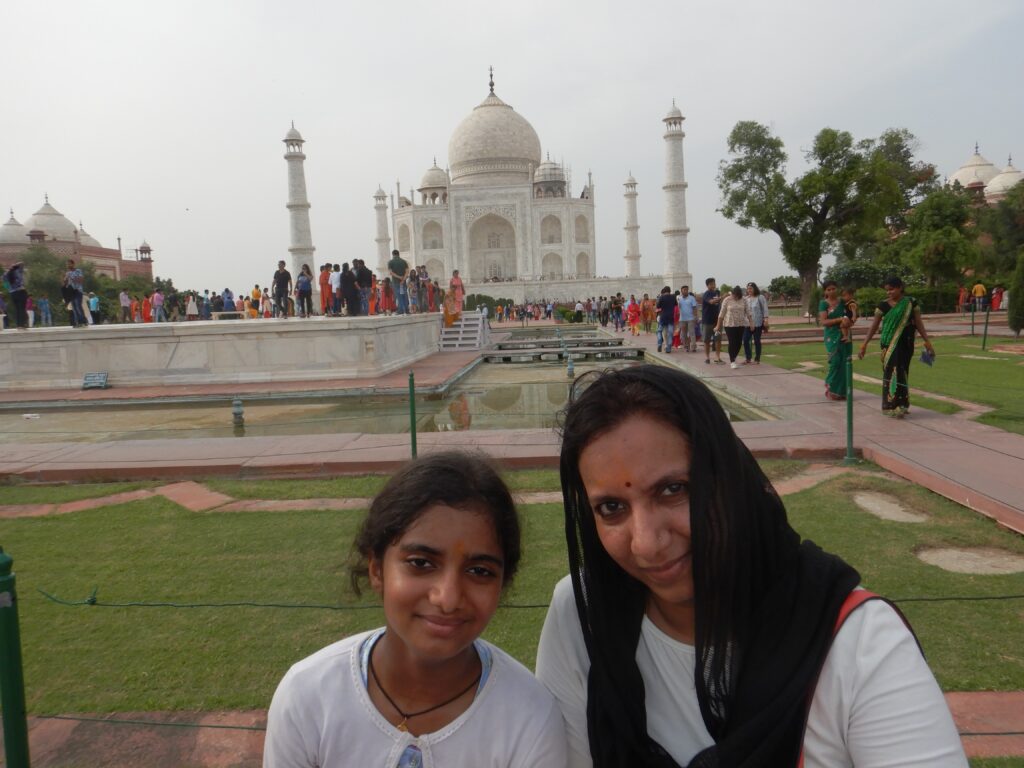 Taj Mahal – In front of the Great Monument of India with my Mother.
Taj Mahal – In front of the Great Monument of India with my Mother.
I believe the only reason for such hard work is love and compassion. We then went to the Agra fort and spend some time there. The long walls of the fort that formed barriers and the large gates and doors showed how the Mughal emperors assures safety and security of the kingdom. The Taj Mahal and the Agra Fort are known as the sister monuments. We then left back to Delhi that night.
 At the Agra fort, taking a rest with brother
At the Agra fort, taking a rest with brother
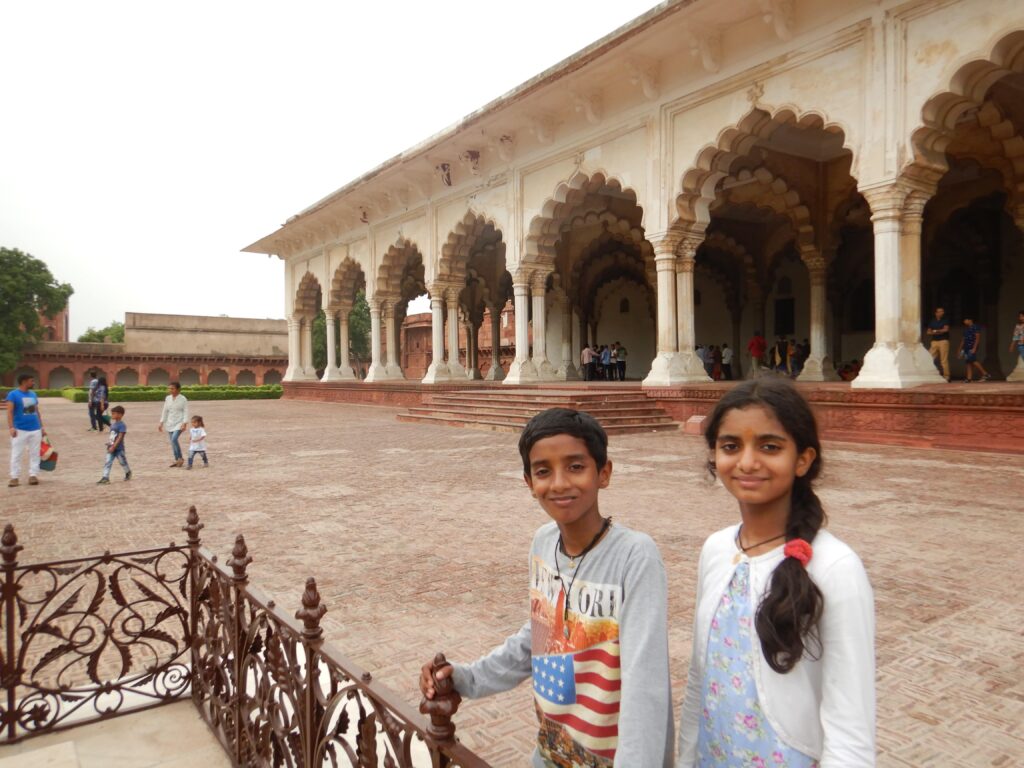 At the Agra fort, standing with brother
At the Agra fort, standing with brother
Seeing the Ganges & Holy places of Rishikesh and Haridwar:
Then we went to the holy places of Rishikesh and Haridwar were the holy river of Ganga is seen flowing vigorously.
 Rishikesh – At the Aarti site on the banks of River Ganges
Rishikesh – At the Aarti site on the banks of River Ganges
 Rishikesh – Witnessing the Ganga Aarti
Rishikesh – Witnessing the Ganga Aarti
 Rishikesh – Ganga Aarti ceremony is underway
Rishikesh – Ganga Aarti ceremony is underway
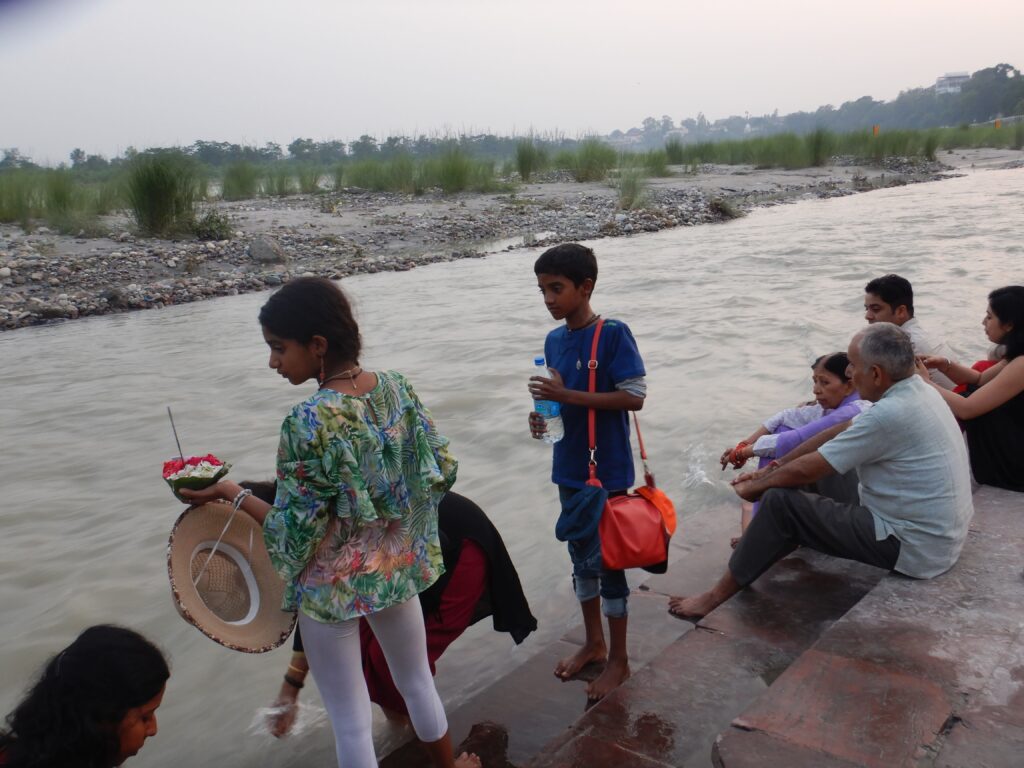 Rishikesh – at the sacred banks of the river Ganga
Rishikesh – at the sacred banks of the river Ganga
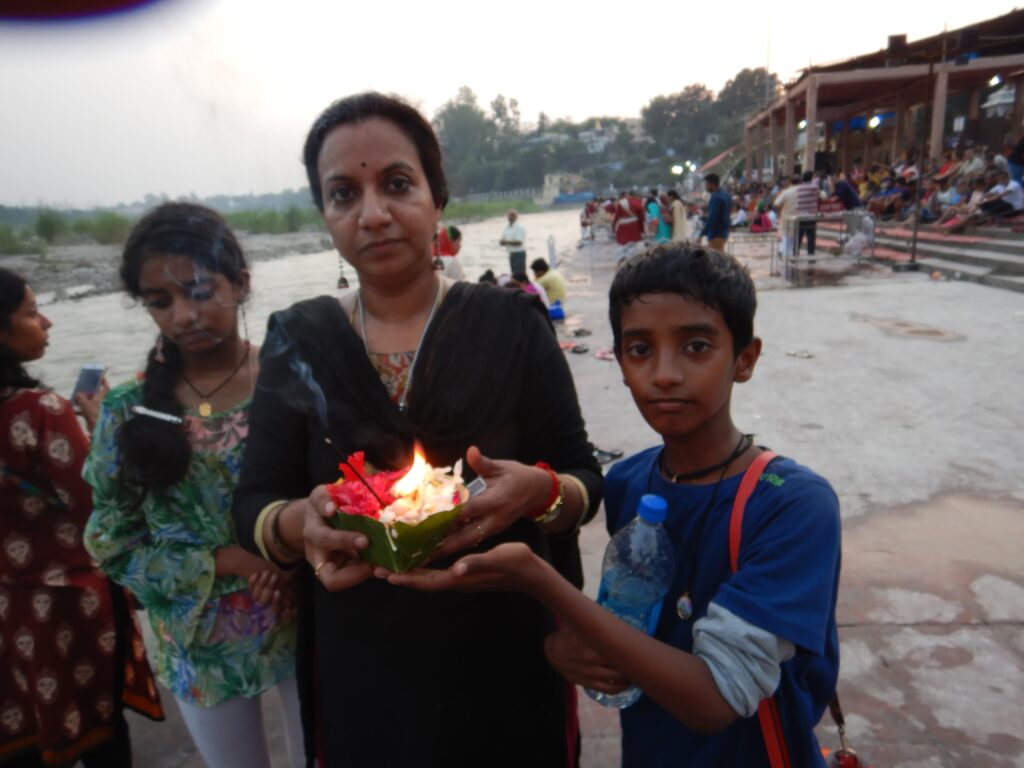 Rishikesh – with Mother holding the Diya
Rishikesh – with Mother holding the Diya
We also took part in the Ganga Aarti done on the banks of the river Ganges in Rishikesh. Small Diyas are lighted and then kept along with some flowers and incense sticks on a leaf. We then place it on the surface of water, watching it float along with the waves of the Ganges was a truly enriching sight.
Manali – the dream hill station of India
After a peaceful evening we left back to Chandigarh by Train through Delhi where Bhim uncle was supposed to come to pick up for our journey to Manali by car.
Manali is one of the most famous hill stations in India. After a long tiring car drive, we reached Manali around 10 pm late night, starting around 11.30 AM from Chandigarh. Bhim uncle told us that he knew a hotel on the way and so we went there to have dinner.
Of course, just as described by him, the hotel was situated on the banks of the Beas river which was seen following us almost everywhere on the way to Manali. I must tell you since we were travelling by car and the road was very steep and at times there were some constructions going on in the sides of the road, I was a little scared of some rockfall from the steep slopes of hills were surrounded by while travelling. Since we reached late night, I could not really enjoy the outskirts of the hills and mountains. That night we stayed in a hotel named “Thomas Villa”.
 Manali – In front of our Hotel, Thomas Villa
Manali – In front of our Hotel, Thomas Villa
This was one of the best hotels in our trip. I was truly awestruck in the morning by the view I saw from our room. I also discovered that our hotel was situated in the banks of a beautiful valley covered with a long unending stretch of the commonly seen Devadaru trees in Manali.
 Manali – In front of a beautiful Tibetan Monastery
Manali – In front of a beautiful Tibetan Monastery
I was completely in awe and wanted to discover more of the beauty of this place. We all got ready pretty quickly and Bhim uncle was there waiting for us standing in front of the car. We then went on to visit the Hidimba Devi temple in Manali.
 Manali – at the Hidimba devi temple with Father
Manali – at the Hidimba devi temple with Father
 Manali – at the Hidimba Devi temple
Manali – at the Hidimba Devi temple
We prayed at the temple for some time. The temple was very different from the temples I have usually gone to.
Visiting the Rohtang pass – crown Jewel of our Manali trip:
One of the most awaited part of the trip for all of us was the Rohtang pass. This pass is 51 km away from Manali and it initiates to Lahaul and Spiti valleys.
It is told that in ancient times when people used to go through this pass, travelers used to even die as they were exposed to the harshly uncomfortable cold weather and lack of oxygen to breathe. I was a little startled when I heard this story from Bhim uncle while we were travelling in the car.
Thinking about this I did not know that we reached the rent shop, from where we rented some jackets suits and other clothing’s without which it would have been difficult to climb up the pass. We brought it to the car and resumed our road journey. The road was very steep. Finally, we reached the pass and took off our rented outfits from the car and began to wear it. The weather was so cold that it made me think how people used to cross this pass in the olden times without any outfits. As I climbed a little, I was feeling a little uncomfortable, so I went back to the car. I was astonished to see my father not wearing any of the rented clothes. I wondered if he would be able to breathe. On the contrary he was the one who climbed the most among all of us. After spending sometime there we went back to the car and Bhim uncle drove. We were then taken to a little moderately cold weather area which was perfect for me. I got out and noticed some ice blocks on the roadside. I picked them up and that was the first time I touched snow that turned into ice.
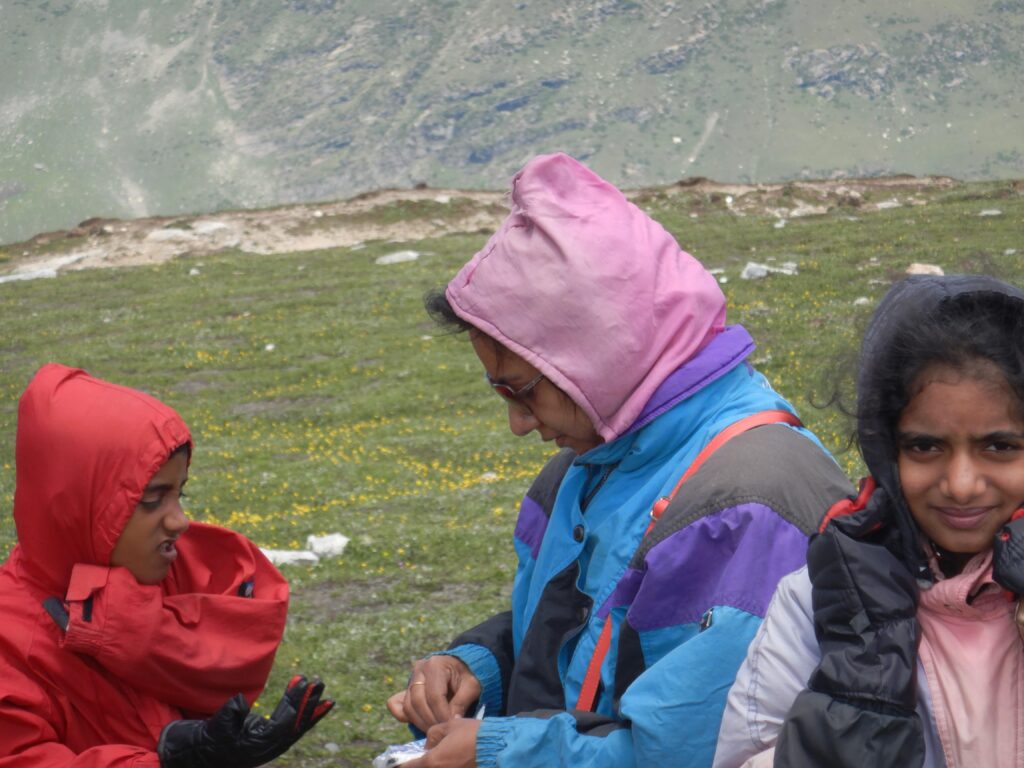 Rohtang Pass – fighting extreme cold even in July
Rohtang Pass – fighting extreme cold even in July
 Rohtang Pass – Touching Ice with that has the story of past snow.
Rohtang Pass – Touching Ice with that has the story of past snow.
 Rohtang Pass – Summit of the Rohtang Pass, a family photo
Rohtang Pass – Summit of the Rohtang Pass, a family photo
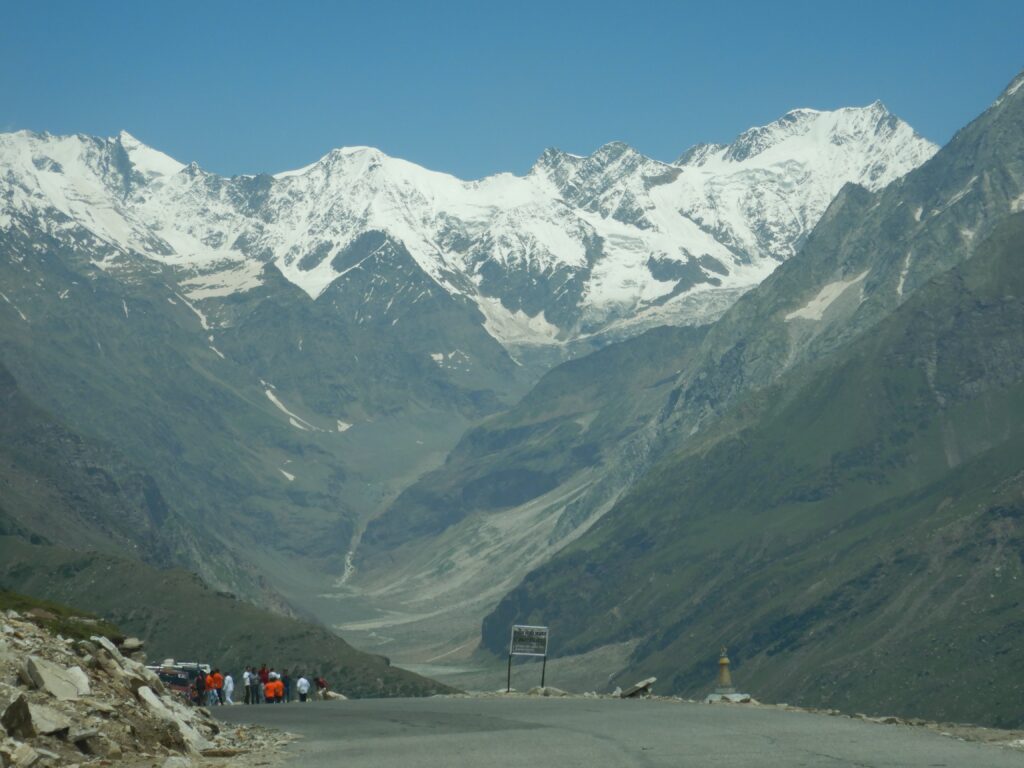 Rohtang Pass – Amazing landscape of Mountains – on the way to Rohtang Pass
Rohtang Pass – Amazing landscape of Mountains – on the way to Rohtang Pass
 Rohtang Pass -Hot Tea to fight the Cold
Rohtang Pass -Hot Tea to fight the Cold
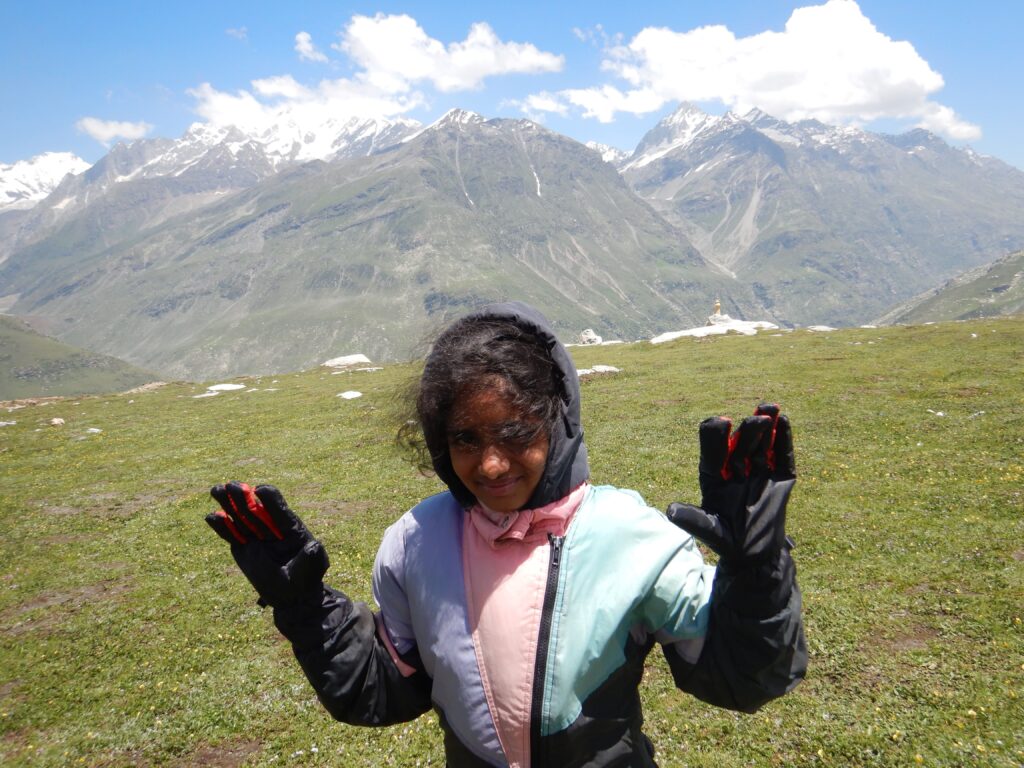 Rohtang Pass – Facing unbearable cold at the Pass
Rohtang Pass – Facing unbearable cold at the Pass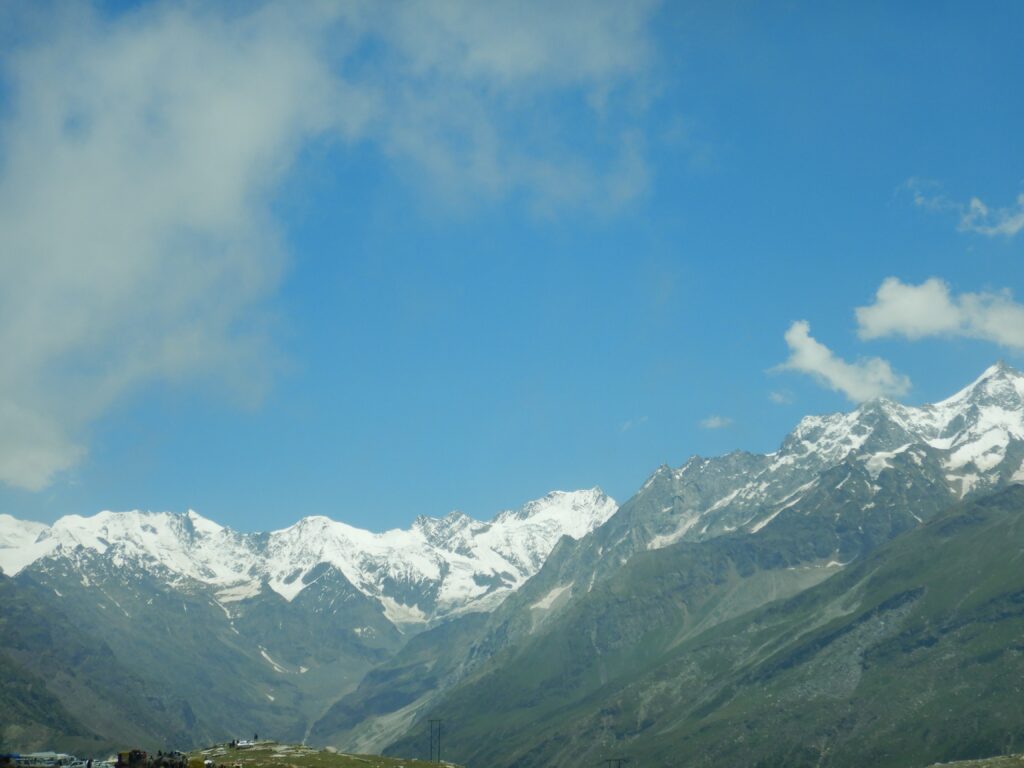 Rohtang Pass – another breathtaking view of the of the snow clad mountains on the way to the Rohtang Pass.
Rohtang Pass – another breathtaking view of the of the snow clad mountains on the way to the Rohtang Pass.
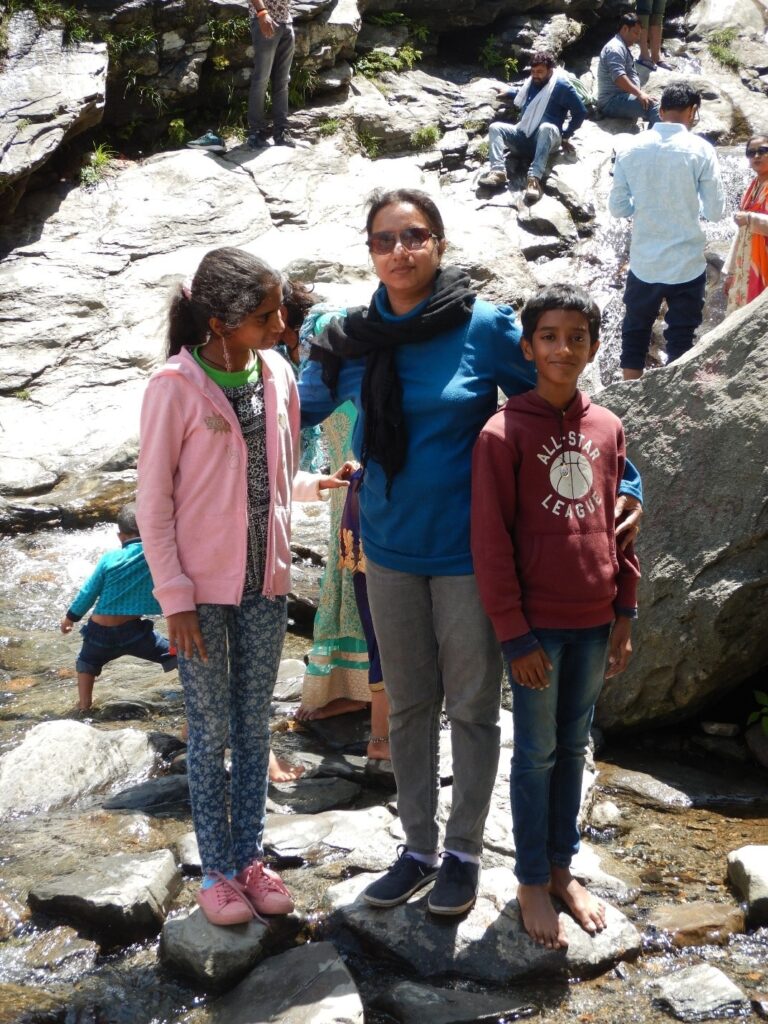 Rohtang Pass – Water fall on the way to the Rohtang Pass
Rohtang Pass – Water fall on the way to the Rohtang Pass
 Rohtang Pass – touching the snow turned to ice in July
Rohtang Pass – touching the snow turned to ice in July
 Rohtang Pass – Waterfall on the way to the Rohtang pass
Rohtang Pass – Waterfall on the way to the Rohtang pass
Then on the way back we got in a hotel. From where we had some hot tea. This made an end to the long maiden north Indian trip I had along with my family.
After returning to Delhi we went on to Chennai to meet my dancing idol Harini Jeevitha. Father described this trip in part of his log article on our trip in the section below.
Chennai, the last leg – Discover India – North India Tour with family.






